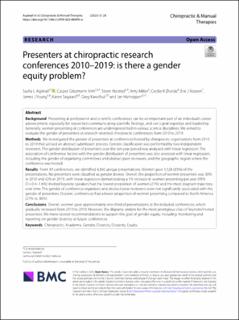| dc.contributor.author | Aspinall, Sasha L | |
| dc.contributor.author | Nim, Casper Glissmann | |
| dc.contributor.author | Harsted, Steen | |
| dc.contributor.author | Miller, Amy | |
| dc.contributor.author | Øverås, Cecilie K. | |
| dc.contributor.author | Roseen, Eric J | |
| dc.contributor.author | Young, James J | |
| dc.contributor.author | Søgaard, Karen | |
| dc.contributor.author | Kawchuk, Greg | |
| dc.contributor.author | Hartvigsen, Jan | |
| dc.date.accessioned | 2023-11-03T08:33:21Z | |
| dc.date.available | 2023-11-03T08:33:21Z | |
| dc.date.created | 2023-09-01T10:33:09Z | |
| dc.date.issued | 2023 | |
| dc.identifier.citation | Chiropractic and Manual Therapies. 2023, 31 (1), . | en_US |
| dc.identifier.issn | 2045-709X | |
| dc.identifier.uri | https://hdl.handle.net/11250/3100412 | |
| dc.description.abstract | Background
Presenting at professional and scientific conferences can be an important part of an individual’s career advancement, especially for researchers communicating scientific findings, and can signal expertise and leadership. Generally, women presenting at conferences are underrepresented in various science disciplines. We aimed to evaluate the gender of presenters at research-oriented chiropractic conferences from 2010 to 2019.
Methods
We investigated the gender of presenters at conferences hosted by chiropractic organisations from 2010 to 2019 that utilised an abstract submission process. Gender classification was performed by two independent reviewers. The gender distribution of presenters over the ten-year period was analysed with linear regression. The association of conference factors with the gender distribution of presenters was also assessed with linear regression, including the gender of organising committees and abstract peer reviewers, and the geographic region where the conference was hosted.
Results
From 39 conferences, we identified 4,340 unique presentations. Women gave 1,528 (35%) of the presentations. No presenters were classified as gender diverse. Overall, the proportion of women presenters was 30% in 2010 and 42% in 2019, with linear regression demonstrating a 1% increase in women presenting per year (95% CI = 0.4–1.6%). Invited/keynote speakers had the lowest proportion of women (21%) and the most stagnant trajectory over time. The gender of conference organisers and abstract peer reviewers were not significantly associated with the gender of presenters. Oceanic conferences had a lower proportion of women presenting compared to North America (27% vs. 36%).
Conclusions
Overall, women gave approximately one-third of presentations at the included conferences, which gradually increased from 2010 to 2019. However, the disparity widens for the most prestigious class of keynote/invited presenters. We make several recommendations to support the goal of gender equity, including monitoring and reporting on gender diversity at future conferences. | en_US |
| dc.language.iso | eng | en_US |
| dc.publisher | BMC | en_US |
| dc.rights | Navngivelse 4.0 Internasjonal | * |
| dc.rights.uri | http://creativecommons.org/licenses/by/4.0/deed.no | * |
| dc.title | Presenters at chiropractic research conferences 2010–2019: is there a gender equity problem? | en_US |
| dc.title.alternative | Presenters at chiropractic research conferences 2010–2019: is there a gender equity problem? | en_US |
| dc.type | Peer reviewed | en_US |
| dc.type | Journal article | en_US |
| dc.description.version | publishedVersion | en_US |
| dc.source.pagenumber | 0 | en_US |
| dc.source.volume | 31 | en_US |
| dc.source.journal | Chiropractic and Manual Therapies | en_US |
| dc.source.issue | 1 | en_US |
| dc.identifier.doi | 10.1186/s12998-023-00498-w | |
| dc.identifier.cristin | 2171568 | |
| cristin.ispublished | true | |
| cristin.fulltext | original | |
| cristin.qualitycode | 1 | |

